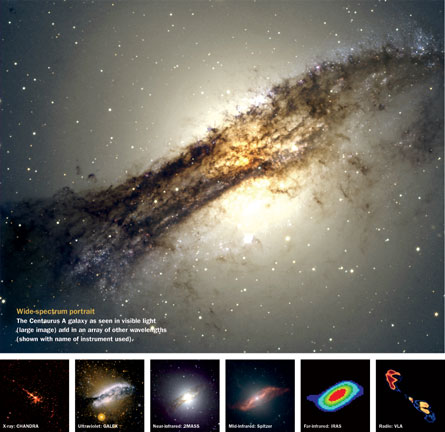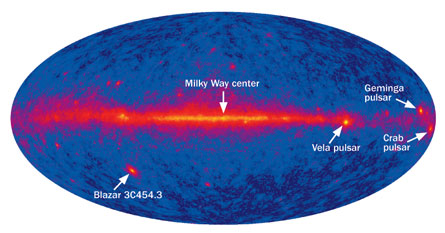Bathed in the painterly light of late afternoon in France’s Loire Valley, an old church casts an orange-tinted glow that streams through a giant, arched window on the ground floor of Blois Castle. One flight up the massive stone staircase, astronomers are convening to talk about a universe of colors—and particles—well beyond this visible tableau.




Astronomers, of course, have viewed the universe at invisible wavelengths of electromagnetic energy, ranging from radio waves to gamma rays, for decades. But a variety of new instruments are throwing wide open certain windows on the cosmos that had previously been lifted only a crack. The new views, some reported on for the first time at the Blois conference in June, promise to retouch astronomers’ portraits of the heavens.
Already, the year-old Fermi Gamma-ray Space Telescope has extended the range and sensitivity with which scientists can scan the high-energy universe for violent interactions and signs of dark matter. In the infrared, NASA’s Spitzer Space Telescope has given astronomers a more complete picture of galaxy and star formation, much of which happens behind a veil of dust. And new radio telescopes will soon probe the cosmic dark ages—the era just before the very first stars and galaxies illuminated the universe.
“People are now dipping into data” from a variety of telescopes that cover a panoply of wavelengths, says Richard Ellis of the California Institute of Technology in Pasadena. “The young people have this multiwavelength attitude that is revolutionizing astronomy.”
Fomenting that revolution are heavenly messengers other than electromagnetic waves, such as high-speed charged particles known as ultra high-energy cosmic rays. And an even more novel window is about to open, MIT astronomer Sam Waldman noted at the meeting in Blois. Detectors around the globe are poised to record a type of energy predicted by Einstein’s theory of general relativity but never before seen: the ripples in spacetime known as gravitational waves. Traveling unimpeded through reaches of the universe opaque to any form of light, these waves may offer previously unattainable views of the universe—including the merger of supermassive black holes and the earliest moments of creation.
Some like it cold
But for a really cool view of the cosmos, astronomers are turning to the infrared. Although infrared space missions began in the 1980s, the Spitzer Space Telescope, launched in 2003, has proved crucial for studies of cold dust and the nature of the earliest galaxies.
Because Spitzer has a small light-gathering mirror, only 85 centimeters in diameter, astronomers figured they would be lucky if the craft could detect galaxies as far away as 11 billion light-years. Since looking farther in space is the same as looking back in time, that distance corresponds to an era when the universe was about 2.7 billion years old. To the astonishment of many astronomers, Spitzer was able to detect galaxies that were much more remote, from a time when the universe was less than a billion years old.
To understand how Spitzer accomplished this feat, consider the effect that the universe’s expansion has on the light emitted by distant objects. Because expansion shifts radiation emitted by distant bodies to longer, redder wavelengths, the infrared light that Spitzer records was actually emitted by distant galaxies as visible light. And visible light is primarily emitted by mature stars.
So for Spitzer to image distant, youthful galaxies, they had to be chock-full of old stars—at least 100 million years old. Spitzer had inexplicably found old stars in the young universe. The first such report appeared four years ago, and the trend continues (SN: 4/25/09, p. 5).
Spitzer’s finding indicates that some galaxies mature in a hurry, forming stars so rapidly that even young galaxies already have aging stars. It also suggests, says Ellis, that the Hubble Space Telescope’s new Wide Field Camera 3, an instrument that primarily views galaxies in visible light and short infrared wavelengths, will be able to see galaxies even farther back in space and time.
That’s because the old stars seen by Spitzer when the universe was about a billion years old would have been spanking new a few hundred million years earlier. And newborn stars emit lots of ultraviolet light, which cosmic expansion shifts into the visible-light and short infrared bands that the new Hubble camera can detect.
“We’re now all eagerly awaiting” new Hubble images, Ellis says. Some have since been released (SN: 9/26/09, p. 7).
The Spitzer telescope has also uncovered vast populations of stars within dusty galaxies that lie hidden in visible light. “In the 1990s, we had the arrogance to imagine that we had solved the problem of [the history of star formation] by just the Hubble Space Telescope alone in visible light,” says Ellis. “But the inventory shows we were missing a huge fraction of star formation occurring in obscured galaxies only seen by Spitzer.”
In May, Spitzer used up its coolant, making it impossible to survey the cosmos beyond an infrared wavelength of 4.5 micrometers. (At longer infrared wavelengths, heat from the telescope interferes with observations.) However, the recently launched Herschel Space Observatory—which features a 3.5-meter–diameter mirror, the largest telescope yet flown in space—is filling in the gap. Herschel opened its eyes in June, viewing the cosmos at wavelengths from 55 to 672 micrometers, a range that includes both far-infrared and slightly longer submillimeter wavelengths. That range will allow Herschel to analyze clouds of dust and gas that mark places where stars and galaxies are born.
These clouds are opaque to visible light and short infrared wavelengths. But as the fledgling stars begin shining, they heat their birth clouds, causing the dust and gas to radiate in the far-infrared and submillimeter wavelengths that Herschel records. The observatory will home in on particular wavelengths of light emitted by specific atoms and molecules in the dust, “telling us about the material from which stars and planets form,” says astronomer Matt Griffin of Cardiff University in Wales.
“Since galaxy formation is star formation writ large, Herschel will be able to study how galaxies formed and evolved by looking deep into space and far back in time,” adds Griffin. The first galaxies that formed were much smaller than today’s galaxies today and grew by merging, a process that triggered enormous bursts of star formation, he notes. “Herschel’s cameras will survey large areas of the sky and carry out the first census of star-forming galaxies throughout cosmic time,” he says.
Closer to home, the observatory will examine planets, comets, and asteroids in Earth’s the solar system, which radiate at wavelengths Herschel can detect.
Tuning in to the early universe
Another group of telescopes promises to help astronomers fill a glaring gap in the cosmic photo album. Images of the cosmic microwave background, the radiation left over from the Big Bang, provide the earliest snapshots of the cosmos—from when it was only about 400,000 years old. Flash forward to the next series of images, which show what some of the first galaxies looked like when the universe was about 850 million years old. The era in between—before stars and galaxies were born—remains a mystery. It’s during these cosmic dark ages that “the primordial soup evolved into the rich zoo of objects we now see on the sky,” says Avi Loeb of Harvard University.
Loeb, along with Jackie Hewitt of MIT, is a member of one of three teams building arrays of radio antennas that will attempt to listen in to this dark era by recording faint emissions from atomic hydrogen. Hydrogen gas emits radiation at a radio wavelength of 21 centimeters when its atoms jump from a particular high energy state to a lower one.
At the beginning of these dark ages, explains Loeb, the universe had cooled sufficiently from its violent birth for protons and electrons to recombine into neutral hydrogen atoms. But by the end of this era, the cosmos had gone through another wrenching transition. Soon after baby galaxies and the brilliant beacons of light known as quasars emerged, they began emitting ultraviolet light, which broke hydrogen atoms back apart into their constituent protons and electrons, a process known as reionization.
The reionization of the universe didn’t happen all at once, Loeb says. Instead, UV light from individual galaxies probably created small bubbles of ionized hydrogen gas—a sea of protons and electrons—around each galaxy. Each bubble grew as galaxies packed on more mass and the UV radiation they emitted intensified. As galaxies and galaxy clusters continued to enlarge, the bubbles overlapped until all the neutral hydrogen had vanished and the entire universe was reionized. (Most of the universe has remained ionized since that early epoch.)
By charting the initial distribution of neutral hydrogen gas and how quickly it ionized, astronomers hope to trace the assembly of the first galaxies. Doing so exploits the effect of cosmic expansion on radio wave signals. The expansion of the universe shifts hydrogen’s 21-centimeter radio emission to longer and longer wavelengths the farther back in space—and therefore time—that the gas resides. So each wavelength of redshifted 21-centimeter radio emission corresponds to a different era in the early universe. Tuning in to each emission will therefore help astronomers map the abundance of neutral hydrogen over time and better determine when the universe, as a whole, got reionized.
Two experiments, the Murchison Widefield Array and PAPER (Precision Array to Probe Epoch of Reionization) are under construction in the radio-quiet outback of Western Australia. Hewitt says she expects Murchison to begin operation in 2011. A third experiment, the Low Frequency Array, is being built in the Netherlands.
Catching some rays
Just as radiation from hydrogen reveals part of the unseen universe, so do hydrogen atoms’ energetic nuclei, or protons. Imagine a proton packing as much oomph as a major league fastball. Protons and other energetic particles making up cosmic rays pelt the Earth, bringing information about some of the most frenzied regions of the cosmos.
At the Blois meeting, though, Nobel laureate James Cronin of the University of Chicago reported a finding so surprising that he and his collaborators didn’t go public with the data for two years, until they could check and recheck the results. Using the Pierre Auger Observatory, a huge array of cosmic ray detectors in Malargüe, Argentina, his team found that many of the highest-energy cosmic rays may not be protons after all, but are composed of iron and other heavy nuclei (SN: 7/18/09, p. 8).
The puzzling part is that the universe consists mainly of protons, and iron and other heavy nuclei account for only perhaps 1 percent of all atoms. That’s true, for example, in the swirling disks of gas and dust that surround supermassive black holes, one possible source of the ultra high-energy cosmic rays. And even if some iron nuclei are revved up to high energies in these disks, another mystery remains. Heavy nuclei are relatively fragile, easily broken apart by collisions before they can reach Earth. Yet these nuclei are what Cronin and his team believe they have detected.
If iron nuclei truly constitute a significant fraction of ultra high-energy cosmic rays, astronomers may have to rethink where the particles come from and how they managed to travel intact to Earth, says Todor Stanev of the University of Delaware in Newark.
In the meantime, says Stanev, a much darker mystery has gripped cosmic ray astronomers. Some observatories, including the PAMELA spacecraft (SN: 2/28/09, p. 16), have recently found an unexplained excess of certain lower-energy cosmic rays—electrons and their antiparticle, positrons—in the Milky Way.
Researchers have proposed that the excess is a signpost of dark matter, the sought-after invisible particles believed to make up about 85 percent of all matter in the universe. Some types of dark matter would annihilate upon impact, creating both gamma rays and pairs of electrons and positrons, theorists say.
But a team including Stanev and Hasan Yüksel of the University of Delaware now proposes a more mundane solution. In the July 31 Physical Review Letters, the team suggests that the source of the electron-positron excess could be Geminga, a rapidly rotating stellar corpse known to emit gamma rays.
If the team is right about Geminga, not only would the excess cosmic rays be explained without invoking dark matter, but the finding would also mark the first time that astronomers have linked cosmic rays to any specific source in the sky. The paths of most low-energy cosmic rays—including the electrons and positrons—are so bent by the galaxy’s magnetic field that their direction of origin is hopelessly lost.
Gammas galore
If hints of dark matter are found soon, they’re likely to come from the Fermi Gamma-ray Space Telescope, Stanev says. Once every three hours, the telescope surveys the entire sky. Researchers scour the data to look for any unexplained excesses in gamma rays coming from the center of the Milky Way, where dark matter may concentrate.
The telescope will have to distinguish gamma rays produced by decaying dark matter from those generated by supernovas and hot gas around black holes. Preliminary results are expected to be announced later this fall. Already, the Fermi observatory has recorded for the first time very high-energy radiation from gamma-ray bursts, the ephemeral blasts believed to signal the collapse of massive stars into black holes (SN: 1/17/09, p. 5).The observatory has also discovered a new class of pulsars that appears to emit only gamma rays (SN Online: 12/8/08) and created new maps of the cosmos’s gamma-ray background.
In April, another gamma-ray observatory called Swift found the most distant gamma-ray burst ever, a 10-second flash emanating from a region more than 13 billion light-years from Earth (SN Online: 4/28/09). Once a gamma-ray burst fades, it usually reveals the galaxy in which it ignited. Extremely remote bursts may therefore act like signal flares, revealing the locations of galaxies so faint and distant that no telescope would ever have found them, says Loeb. Hubble’s proposed successor, the James Webb Space Telescope (scheduled for launch in 2014), may be the only telescope capable of imaging the home galaxies of such distant bursts.
New wrinkles in spacetime
A gamma-ray burst may mark a black hole’s birth, but a novel detector may one day directly record the activity of these gravitational beasts. Just as a charged particle emits electromagnetic waves when it moves up and down, a massive body emits gravitational waves when it accelerates. Detecting gravitational waves would offer views of black hole mergers, notes theorist Marc Kamionkowski of Caltech.
Scientists aim to detect gravitational waves by the motion they induce in free-floating masses. A typical sensor consists of an L-shaped arm with mirrored weights hanging at each end of the L and at the vertex. A passing wave compresses one arm while stretching the other. Each arm may be a kilometer long. Using lasers, researchers can now record changes in the relative arm lengths as tiny as 10 billionths the diameter of a hydrogen atom, Waldman says.
Researchers have been searching for gravitational waves for decades, but none have yet been found. Given the precision of current detectors, even this absence can be significant. Some models of the early universe, which predict a flood of gravitational waves from the Big Bang, may be ruled out by the nondetection, researchers from two gravitational-wave experiments report in the Aug. 20 Nature.
While seeing nothing does not eliminate “any dearly held theoretical prediction, it presents a watershed event,” comments Kamionkowski.
Researchers are now building a new generation of experiments designed to see gravitational waves generated when two compact bodies—neutron stars or small black holes—spiral toward each other.
But the most dramatic sources of gravitational waves are likely to be recorded by detectors in space. A trio of proposed spacecraft known as LISA would detect much longer wavelength gravitational waves, such as those thought to be generated when galaxies collide and their black holes merge. LISA could also detect gravitational waves generated during the universe’s explosive birth.
By themselves, gravitational waves won’t reveal the distance to the celestial sources that produce the waves. However, if a counterpart can be identified in visible light, gamma rays, or another part of the electromagnetic spectrum, then the gravitational waves may truly act as sirens, signaling the location of some of the most violent maelstroms in the universe.
“One of the big triumphs in all this new territory,” says Ellis, is that astronomers are teaming up to train different telescopes on the same patch of sky. Astronomers were once color-blind, restricting themselves to one wavelength or one type of particle to study the universe. Now, he says, researchers are finally transforming this black-and-white view of the cosmos into Technicolor.







